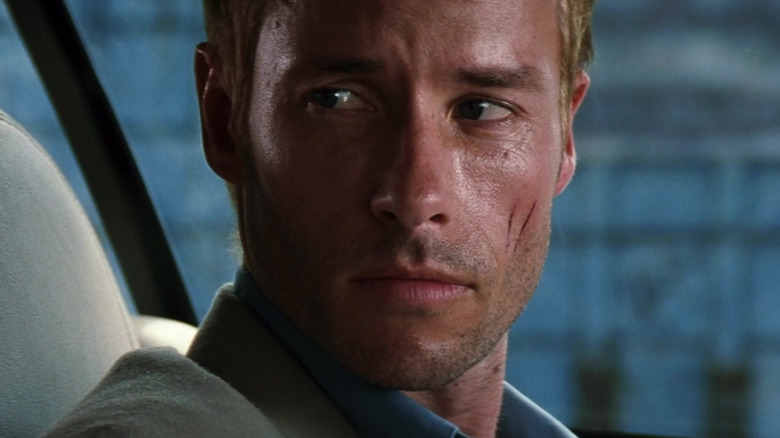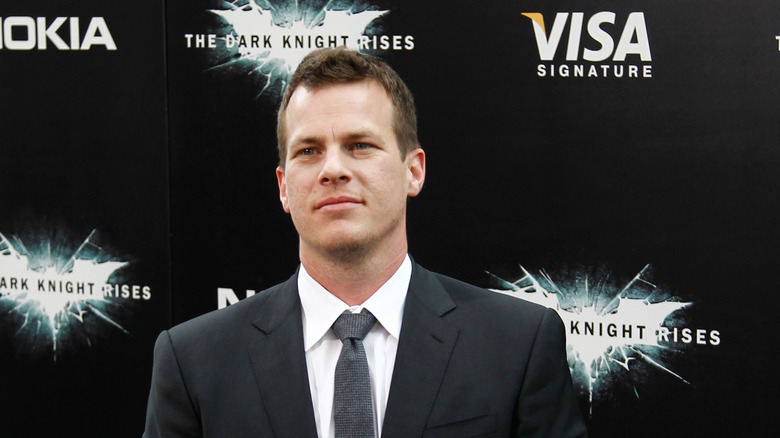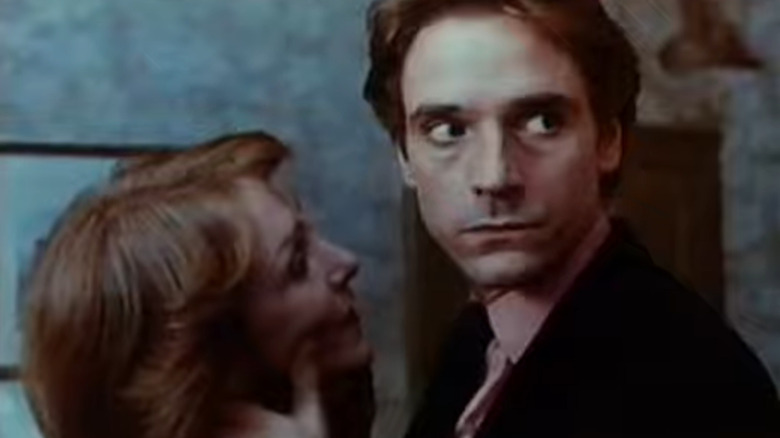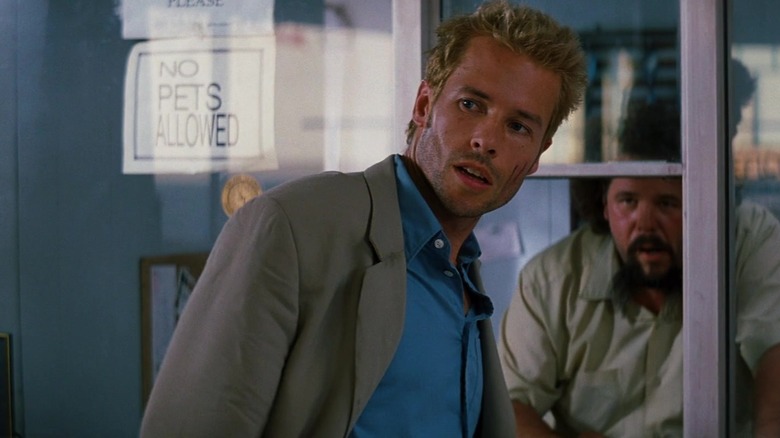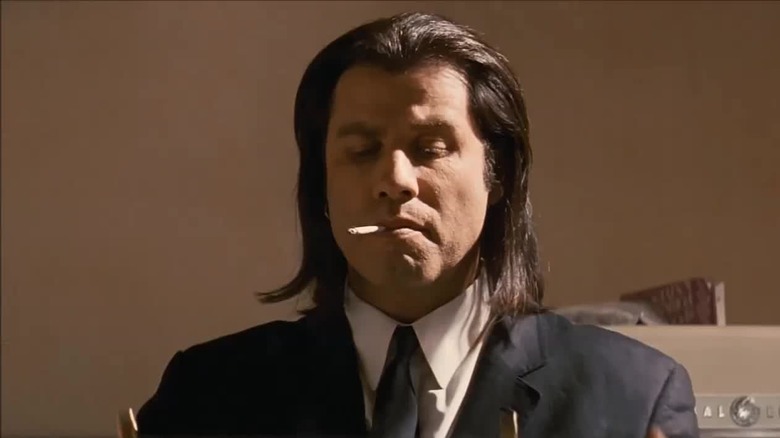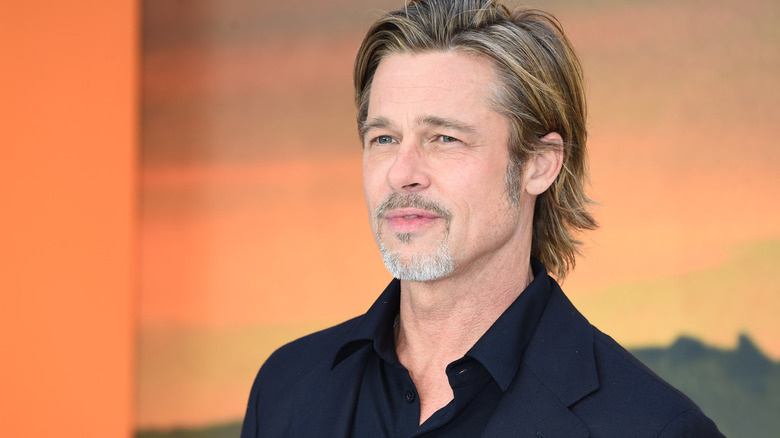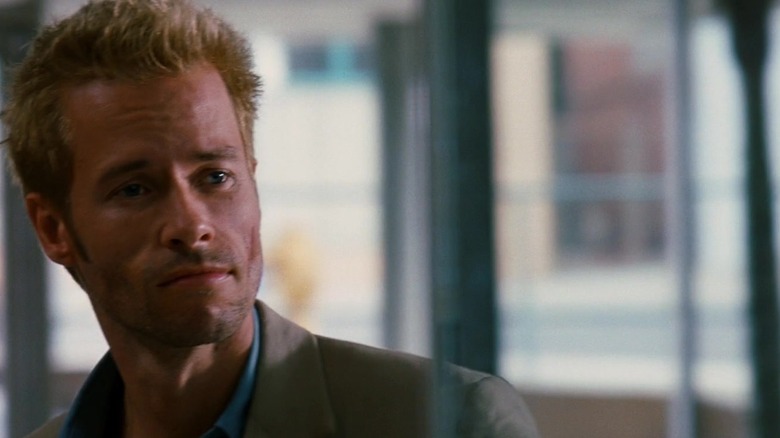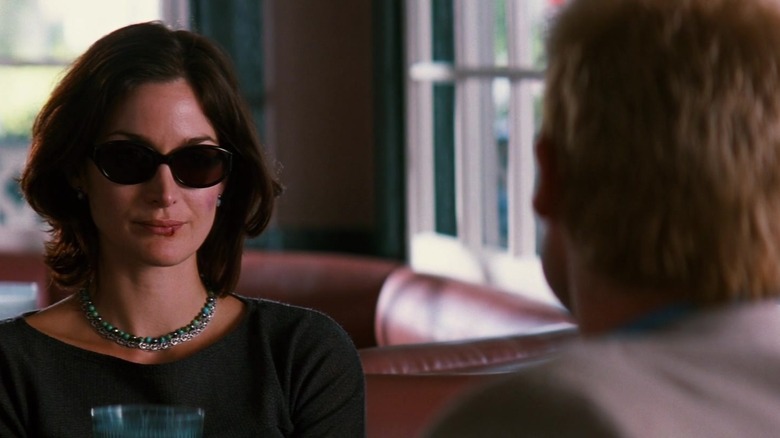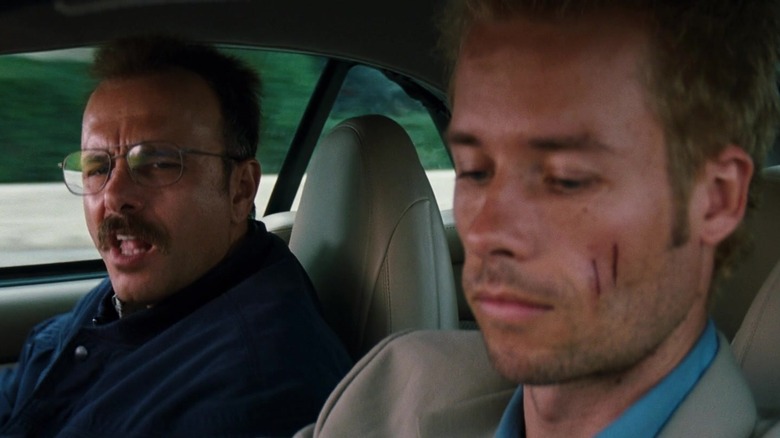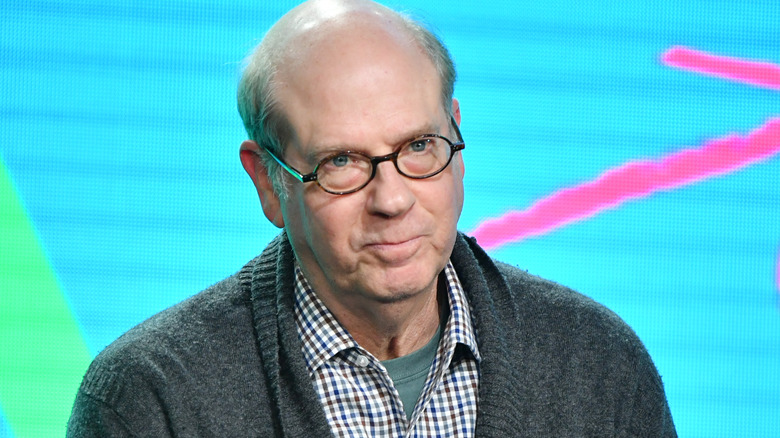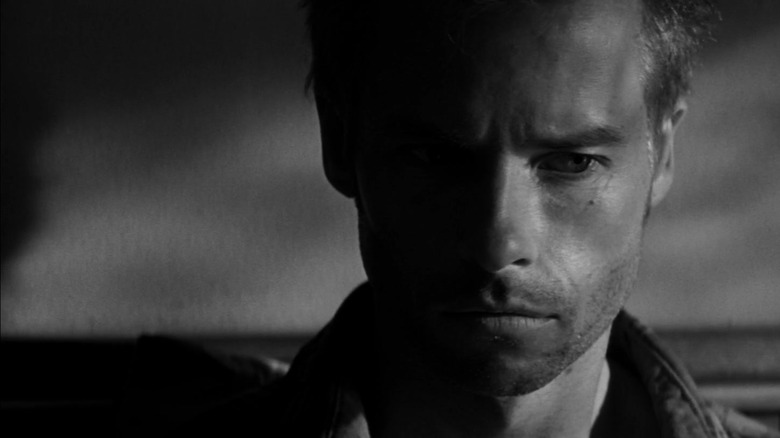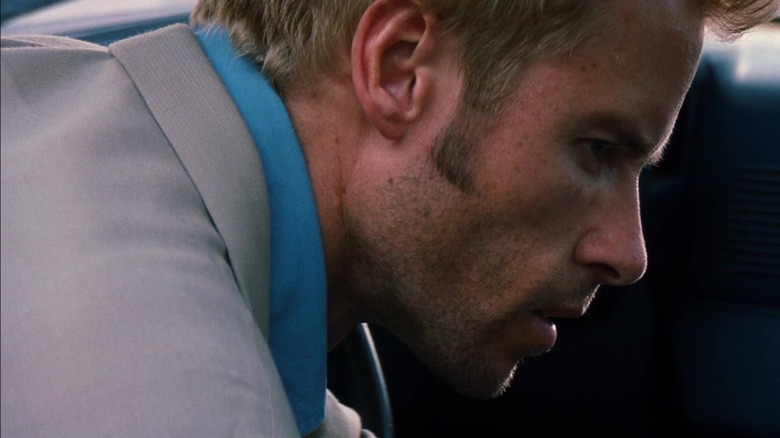The Untold Truth Of Memento
When "Memento" was released on March 16, 2001, it signaled the arrival of a major new filmmaking talent. Directed and written by Christopher Nolan, "Memento" is a thriller about a man named Leonard Shelby who is trying to avenge the death of his wife. The problem is that he has short-term memory loss and he has to take photos and tattoo himself to keep track of things.
Not only does the film feature a terrific performance from Guy Pearce in the lead role of Leonard, but it also tells the story both chronologically and in reverse, beginning with the ending. "Memento" is not just impressive because of the performances and the intricacies of the story, but it was also shot for less than $10 million on a 25-day schedule (via IndieWire).
While "Memento" got a lot of press and critical acclaim, there's a lot you may not know or may have forgotten about the movie. Here's the untold truth of "Memento."
Memento put Christopher Nolan on the map
These days, Christopher Nolan is a big deal. His Batman films have made boatloads of money. He's had big hits with epic, challenging works like "Inception" and "Interstellar." He's also one of the only directors who can get his movies made on celluloid, while everyone else has to work on digital (via the DGA).
And with his upcoming movie, "Oppenheimer," Nolan demanded, and got, complete creative control over the film, 20% of the first-dollar gross, and the promise that the film will play theatrically for 100 days before it goes to streaming (per IGN.com).
All of this started with "Memento," which made it clear that he was a major new talent. His trajectory from "Memento" to Batman feels similar to Peter Jackson ("Lord of the Rings"), another filmmaking wunderkind who could do a lot with a small budget and a lot of ingenuity. Once both filmmakers got bigger budgets and more resources, they really showed what they were capable of.
As one critic noted that when he first saw Nolan's early work, he was "struck with the same feelings as watching 'El Mariachi' [Robert Rodriguez's feature-length debut]. It doesn't matter how expensive the film is; the person who made this is a born, bonafide, instinctual filmmaker through and through" (via Collider).
"Memento" showed Nolan could tackle challenging, nonlinear storytelling and complex characters. Once Nolan took the big leap to the "Dark Knight" series, he said he was "excited to contribute to the lore surrounding the character," and that Batman was "the most credible and realistic of the superheroes, and has the most complex human psychology" (per Variety).
Christopher Nolan co-wrote the film with his brother Jonathan
With Christopher Nolan getting most of the attention in the media, many don't realize his brother, Jonathan Nolan, is a strong creative force in his own right. He co-wrote many of his brother's films and is also the co-creator of the hit sci-fi series "Westworld."
In fact, Christopher and Jonathan wrote the story for "Memento" together. As Christopher recalled, his brother told him the idea when they were traveling from Chicago to L.A. (via IndieWire). They both agreed to tell the story in the first person; Jonathan wrote it as a short story, titled "Memento Mori," and Christopher wrote it as a screenplay. As Jonathan recalled (per Filmmaker), "I had taken a semester off from college, and was doing some traveling. I had read about this condition in one of my General Psych classes, and I already had a number of different things that I knew I wanted to deal with in a story, ideas about identity and memory."
Jonathan was interested in how trauma affects memory, and he realized, "In some cases, obviously, people are flooded with memories, and they can't escape them, but I was more interested in situations where people force themselves to remember the bad things that happened. I got very interested in the idea of a character who was stuck in that moment."
It has similarities to a movie called Betrayal
"Memento" has been praised for its innovative structure, but it's not the first time a story has been told backwards. In fact, some believe it was influenced by a 1978 stage play called "Betrayal," which was turned into a film in 1983 (per Yahoo Tech).
"Betrayal" was written by acclaimed playwright Harold Pinter, and it tells the story of an affair and its terrible aftermath. There are three characters in the story, and like "Memento" it starts at the end, and ends at the beginning. (The film starred Jeremy Irons, Ben Kingsley, and Patricia Hodge). "Betrayal" showed that a backward structure could work incredibly well in the right hands. As Roger Ebert wrote in his review, "The absolutely brilliant thing about 'Betrayal' is that it is a love story told backward. [...] But what makes it all work is the structure."
"Memento" was able to make a much more commercial film out of the idea of telling a story backward, but "Betrayal" is still an acclaimed work, and it was recently revived on the London stage with Tom Hiddleston (best known for playing Loki) in the lead (via The Independent).
It's an accurate portrait of amnesia
Audiences who loved "Memento" may be surprised to learn that Leonard's condition is real, and experts claim the film showed the condition accurately. Leonard's condition is called severe anterograde amnesia, and as a neurologist wrote in The BMJ, "Unlike in most films in this genre, this amnesic character retains his identity, has little retrograde amnesia, and shows several of the severe everyday memory difficulties associated with the disorder. The fragmented, almost mosaic quality to the sequence of scenes in the film also cleverly reflects the 'perpetual present' nature of the syndrome."
Christof Koch, a neuroscientist from Caltech, also explained that "Memento" features "the most accurate portrayal of the different memory systems in the popular media.
In later years, a research study was conducted on how the brain reacts to "Memento" and how it can help scientists understand brain issues like Alzheimer's. As Neuroscience News reports, this study looked at how scenes in the film caused reactions in the brain: "The results deepen our understanding of how the brain functions, how narratives work in film, and memory mechanisms impaired by conditions such as Alzheimer's disease."
It came from an era when movies loved nonlinear structures
"Memento" came at the tail end of an era when directors were experimenting with nonlinear storytelling structures and twist endings, like modern takes on the twisted narratives of film noir. Quentin Tarantino helped launch the trend by telling his stories out of order with "Reservoir Dogs" and "Pulp Fiction," and he showed that you didn't have to follow linear storytelling rules to make an effective movie. Other nonlinear or experimental stories at the time were mostly crime thrillers, including 1995's "The Usual Suspects," 1998's "Out of Sight," "Sliding Doors" and "Run Lola Run."
In writing "Memento," Christopher Nolan was influenced by books, where you can play around with narrative and structure more than you can in a movie. He loved a book called "Waterland" by Graham Swift that had a very complex storyline, and it deftly juggles a number of parallel timelines well (per IndieWire). Nolan loved the freedom a writer could have in writing a book, and he wanted to bring that to "Memento." The filmmaker said, "To me it really is a question of finding the most suitable order for releasing information to the audience and not feeling any responsibility to do it chronologically, just like we don't in life."
Brad Pitt was considered for the lead
In casting "Memento," Christopher Nolan had the good fortune of landing Guy Pierce to play Leonard Shelby. (Pearce got strong notices for "L.A. Confidential.") Yet at one point Brad Pitt was reportedly up for the lead, which could have made the film an even bigger hit.
Pitt's interest in the film also helped build a buzz for the project. As Nolan remembered (via Yahoo! Movies UK), "He did read the script. [...] He met with me about it when he didn't have any reason to know who I was or anything about it." While nothing came of this, word started to build that Pitt was up for the project, and this "perked up a lot of interest in what was a very obscure project," Nolan continued. Soon Guy Pearce was considered for the project, and his involvement ultimately got the film underway.
Alec Baldwin, Aaron Eckhart, Charlie Sheen, and Thomas Jane almost starred as Leonard as well (per Koimoi). Ultimately, Pearce was so enthusiastic about the project and Nolan as a storyteller that Nolan was convinced to make the film with a lesser-known actor in the lead role (per Empire). Oftentimes when an A-list movie star plays the role, the audience still sees the star instead of the character he's supposed to be playing.
The film was shot from Leonard's point of view
In making "Memento," Christopher Nolan made a wise storytelling decision in making the film from Leonard's point of view, which made the story feel even more suspenseful to the audience. This is also why Nolan decided to tell the story backward, "so that it denied the audience the information that the protagonist is denied," he explained (via Creative Screenwriting). "I asked myself how do I tell a first-person story through the eyes of someone who, when he meets someone, does not know when or how they've met [before] or whether that person should be trusted? The answer was to put the audience in that position."
Nolan wanted to block the action in the film from Leonard's point of view so that the audience would be looking over his shoulder in a sense. "It's tricking the audience, drawing the audience into this other point of view," he said (via IndieWire). "I think it's tremendously powerful, because people don't realize it's being done because it has to be done in fairly subtle ways." (When he's shooting the dramatic scenes in his films, Nolan also prefers to use only one camera, per the DGA.)
Memento had a hard time getting a distributor
As strong as the film was, "Memento" had a hard time getting a distributor, and it finally landed one with the help of Steven Soderbergh, the director of "Sex, Lies, and Videotape," "Traffic," "Out of Sight," and "Erin Brockovich."
As Christopher Nolan recalled (per The A.V. Club), he knew the film would be potentially hard for audiences to grasp, but he suffered from six months of limbo with no plan for a release. "That's a long time to be under that kind of pressure," he said. "I think the problem was a lack of adventurousness on the part of the so-called independent studios."
Soderbergh knew Nolan was having a hard time finding a distributor, and he helped spread the word that "Memento" was a terrific film (per The Atlantic). "Memento" finally landed at Newmarket, an indie company that's now defunct, and Nolan thankfully avoided the nightmare of landing at a company like Miramax. With Newmarket distributing, the film was a hit, grossing $40 million worldwide, far exceeding its $9 million budget.
Memento was shot on a low budget and a tight schedule
Orson Welles famously said, "The enemy of art is the absence of limitations," and many filmmakers make great work when they don't have a lot of time or money to play with. It ultimately forces them to focus and get the job done.
When Christopher Nolan made "Memento," he wasn't an A-List director yet and didn't have unlimited resources to work with. The film reportedly cost $9 million, and it was shot on a tight 25-day schedule. "The film looks more expensive than it is," Nolan said (via IndieWire). Before making "Memento," Nolan directed an acclaimed thriller called "Following," which he made for a mere $6,000 (via The Atlantic). He called the jump from the microbudget "Following" to the $9 million "Memento" "by far the biggest leap I've ever made. It was a bit like learning to swim once you're out of your depth" (via the DGA).
As Nolan himself noted (via YouTube), "The spontaneity you're able to achieve shooting a movie [low-budget] gives you an incredible freedom. [...] One of the keys to getting an ultra-low-budget film actually finished is definitely to have in mind what kind of film you can make with the resources available to you." He also said that when "Memento" started playing at festivals, which was at the end of the era of indie filmmaking including films "Slacker" and "Clerks," movies were almost competing to see who can make the best movie for the least amount of money.
Stephen Tobolowsky actually suffered from amnesia
Character actor Stephen Tobolowsky is very proud of his work in "Memento" as Sammy Jankis, and he said (per Den of Geek) it was "quite possibly the best script I've ever read." Tobolowsky also knew he was perfect for the role because he suffered from amnesia in real life.
Tobolowsky was treated for a kidney stone operation and was given an experimental drug instead of anesthesia, and it gave him amnesia. As the actor recalled, "I would be in my living room and then boom! It was like I was just born. The worst was when I was standing over the toilet and suddenly didn't know if I was about to pee or if I had already peed."
When the actor met Christopher Nolan, he told him, "You are going to have actors all over this city that will want to be in this. However, I am going to be the only person that wants to be Sammy Jankis who has actually had amnesia."
The film had some of its actors second-guessing themselves, too. Guy Pearce was questioning the reliability of his memory after making the movie (via Republicworld), saying, "I would look at a photo and would be thinking about a memory around it and then go, 'Well I don't know if that memory is really true at all.'"
The dialogue in the black-and-white scenes was improvised
In addition to telling the story in reverse, "Memento" also has haunting segments that were shot in black and white. As it turns out, the dialogue in some of these scenes was improvised. As Stephen Tobolowsky remembered (via The A.V. Club), the script had no dialogue for his character, and Christopher Nolan wanted him to improvise to make the scenes feel more organic. Considering the character had amnesia, this was a big challenge for Tobolowsky. "Part of my brain had to remember what it was doing, and another part had to not remember what I was doing," he said. Tobolowsky said playing Sammy Jankis was "the most difficult role I've ever had, but one of the most rewarding."
Most of Guy Pearce's voiceover dialogue transitions among scenes were reportedly improvised as well (via FilmFracture), a risky way to work that thankfully paid off.
Memento was designed for multiple viewings
It's not surprising to learn that there have been plans since 2015 to remake "Memento" (per The Hollywood Reporter), but it's going to be hard to top the original. With "Memento," Christopher Nolan created a compelling thriller told in a unique way, and he crafted a complex narrative that you had to pay attention to.
Nolan said (via IndieWire) he's interested "in making films to watch them a second time, and hopefully you'll be interested to watch a second time. [...] I feel like I've got three years to work on this thing and as a viewer you've got like two hours to watch it, so it ought to be functioning at some level of greater sophistication than you can absorb in one viewing."
He also came up with a theory that he calls "the pizza delivery scenario" (via The Los Angeles Times). If you order a pizza and get up to go to the door and pay for it, you miss a few minutes of whatever you're watching. With some movies, you can get away with this, he said, but you certainly can't afford to miss three or four minutes with "Memento." "If you come in three minutes late you miss the whole movie," he said.
Judging by the film's success, audiences certainly paid close attention to "Memento," and two decades later, the film is in no danger of being forgotten.
